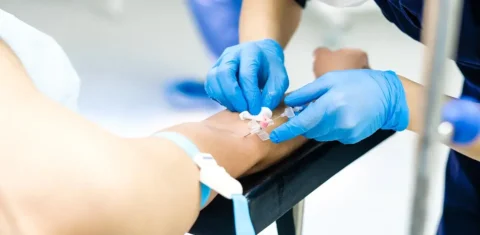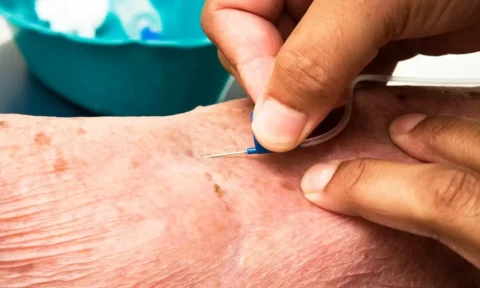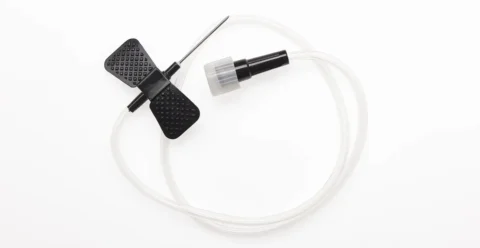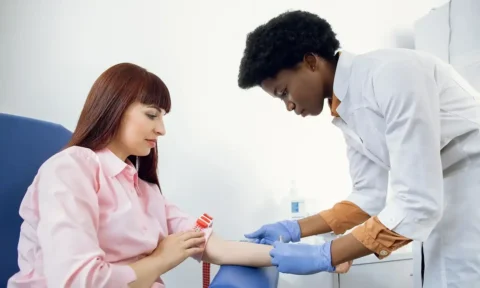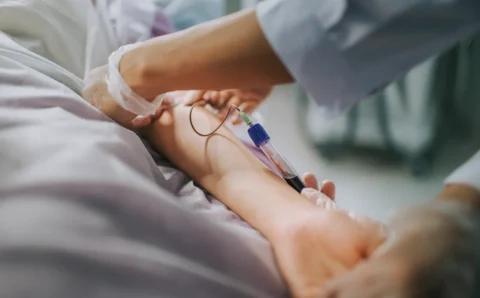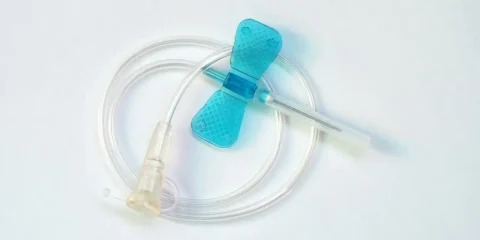Performing injections is one of the most basic yet vital medical procedures, be it for blood collection, IV therapy, or intravenous medications. Since you’re inserting a thin needle into thin, barely-visible veins, some medical professionals can’t help shaking their hands as they insert the needle, especially if they’re using a small needle into superficial veins with butterfly needles.
So how do you stop your hands from shaking when inserting a butterfly needle? To keep your hands from shaking, you might want to try relaxing your shoulders, finding a more comfortable position, and resting your hand on a surface as you insert the needle. Some experts have also suggested taking a deep breath, exhaling slowly, and focusing on the injection site. Take your time and reassure the patient, so you won’t feel conscious of them watching you.
How to Prevent Shaking When Inserting a Butterfly Needle
A butterfly needle or a winged infusion set is a device used to puncture a small vein for collecting a blood sample, giving an IV fluid, or administering medication when the patient can’t have them orally.
A winged infusion set has a smaller and thinner needle than a straight needle. It has plastic flaps on either side, resembling a butterfly. Its small needles allow phlebotomists to access thin, superficial veins, with the winged flaps allowing better grip and control of the equipment.
Butterfly needles are easy to use and less painful on the patient than normal needles, but some practitioners still worry about their hands shaking when using this equipment. Experts also mention how this is normal for many phlebotomists. With experience, the shaking would stop. It might also not go away, but it wouldn’t keep you from safely performing the procedure.
Expert medical professionals recommend relaxing the shoulders, sitting next to the patient, or resting your hand on a surface. You may also take a deep breath and exhale slowly while inserting the small needle into the puncture site. You can also be more familiar with your body and do what works for you keeping you more relaxed and focused. It also helps to focus on the vein, practice your muscle memory, reassure the patient, and take your time.
1) Relax Your Shoulders
It’s normal to feel tense, especially when you’re just starting your career as a phlebotomist. A tip shared by some nurse instructors to stop hand tremors when using a butterfly needle or even a straight needle is to relax your shoulders.
Relaxing your shoulders can help relieve the shaking of your hand when doing a blood draw or inserting IV fluid with a butterfly needle. This is because your hands tend to shake when your shoulders are too tense.
2) Consider Sitting Next to the Patient
Some phlebotomists stand and bend over while performing a butterfly needle insertion on a patient’s fragile needle. This position makes you feel less relaxed and applies too much tension to your muscles and body, like your legs, core, and shoulders.
Experienced nurses and medical technicians also recommend sitting next to the patient when inserting a butterfly needle. This allows you to be more relaxed, allowing focus on the puncture site and the muscles you need for performing the procedure.
3) Rest Your Hand
If you have minimal balance and support, you may find it more challenging to stabilize your hand and insert the butterfly needle without shaking. You might want to rest your hands or elbows on a flat surface.
Some highly-trained professionals suggest resting your hand or elbow on a flat surface. This allows your arm to be more relaxed and stable to keep your hand from shaking as you’re inserting a butterfly needle into a puncture site.
4) Take a Deep Breath and Exhale Slowly
Unsteady breathing may contribute to involuntary hand movements as you insert the butterfly needle. Taking deep breaths and exhaling slowly while inserting butterfly needles can also help you relax and stop hand tremors, according to experienced nurses and medical technicians. This allows your hand to sync with your body, resulting in minimal shaking.
5) Familiarize Yourself with Your Body
There can be many reasons why your hand shakes whenever you try to insert a butterfly needle into the puncture site. No one can know your body better than you, so you might want to be more familiar with your body. Shift the tension and relaxation to different muscle groups of your body, resulting in minimal hand shaking when using the winged infusion set.
This might sound too abstract at first. But it might help to know what some health professionals do — some experienced phlebotomists have shared that pursing their lips works more for them to become more focused and establish better control of their hands. Others have shared that opening their lips slightly allowed their eye muscles to relax. This allowed them better control of their hands with minimal shaking.
6) Focus on the Vein
Focusing on the vein or puncture site may also help you lessen the shaking of your hand. It shifts your attention on the injection site and off your hand, possibly reducing the tremors. Your hands may shake because you might be over-attentive to it.
7) Practice Your Muscle Memory
Your hands tend to shake sometimes when your muscles aren’t used to the movement yet. That’s why many medical professionals build their muscle memory as early as when they’re still trainees. One way to do this is to hold a ballpoint pen with your hand and remove its cap using only your index finger.
Generally, hand tremors are pretty normal when you’re just starting your career, causing you to become nervous. Practicing, gaining experience, and building confidence will help you conduct venipuncture procedures with a butterfly needle properly.
8) Keep the Patient Relaxed
Our hands tend to shake as we insert the butterfly needle when we feel too anxious or self-conscious about how the patient stares at what we do. It also doesn’t help when they look visibly nervous and doubtful about you. Your patient feeling squeamish about receiving injections is pretty normal — they may be scared of the needles, blood, or simply of the pain from the procedure.
A nervous patient can affect you and worsen hand tremors, especially when you’re just starting your career as a phlebotomist or a medical professional. Experienced phlebotomists suggest reassuring your patients and keeping them relaxed first before starting the treatment.
You can start a conversation with them to keep them occupied or suggest they look away, so they’ll feel less anxious. This will also keep you less self-conscious and more focused on the needle and puncture site.
9) Take Your Time
Your hands might shake too much during the insertion of a winged infusion set because you’re too self-conscious about wrapping up the procedure, either you’re doing a blood draw or inserting an IV fluid. While being in the medical field necessitates quick and snappy work, you should take your time and concentrate on doing the task right.
10) Ensure Proper Grip
You should also ensure that you have the right grip on the butterfly needle to minimize the shaking of your hand. Nurse instructors recommend using your index finger and thumb to hold the adaptor. Lay your other fingers on the arm and put the hand’s weight on them to prevent your hands from shaking. Review what you’ve learned and do more practice on gripping a butterfly or straight needle to build muscle memory and reduce shaking.
11) Reduce Your Caffeine Intake
You may have drunk too much coffee, resulting in hand tremors while conducting an IV infusion or collecting a blood sample. Other food and beverages that might cause hand shaking are tea, chocolates, energy drinks, or anything that might contain caffeine.
Caffeine causes blood pressure and heart rate to spike, causing minor hand tremors. You might want to limit your consumption of coffee or other caffeinated drinks to reduce hand shaking when performing a blood draw or IV infusion with a butterfly needle.
12) Consult Your Doctor About Taking Beta-Blockers
You might want to consult your doctor about taking beta-blockers if the shaking of your hand still concerns you, despite trying out the advice of experienced phlebotomists. As mentioned above, experiencing subtle hand tremors is one of the signs of having a high heart rate and blood pressure. Beta-blockers might stabilize your blood circulation and limit the shaking of your hands.
Why Your Hands Shake When Administering a Butterfly Needle
There are many reasons why your hand shakes when using a butterfly needle or even a straight needle when conducting a blood collection or IV infusion. You may experience this due to nervousness from inexperience, anxiety, tense muscles, caffeine intake, or incorrect hand placement.
1) Nervousness from Inexperience
Your hands might shake when inserting the butterfly needle when taking a blood sample or conducting IV therapy due to nervousness. You might be too restless because you’re just starting your career in the medical field, and you’ve yet to gather much experience and confidence.
Experienced phlebotomists assure you that this is normal — you only have to be more confident and remember all the lessons you’ve had. Expose yourself to different opportunities allowing you to gain practice and experience.
2) Anxiety
Your hands might also shake due to anxiety from a patient being too nervous about you performing the procedure or any other situation. While butterfly needles cause minimal pain only, many patients still become squeamish about a needle being inserted into their upper arm.
It might help to reassure and calm the patient. Do breathing exercises to ease your anxiety. But if it becomes too overwhelming, you may also consult your superior and ask other practitioners who might be more comfortable conducting the procedure to take over.
3) Tense Muscles
Your muscles may be too tense, causing your hand to shake too much when using a butterfly needle for blood collection or IV therapy. Experienced phlebotomists note that your hand might shake more than usual if your shoulders are too tense.
Your hands might also shake during needle insertion because you’re in an uncomfortable position, like bending over. You might want to find a position that can relax your muscles and allow you to focus on administering the needle.
4) Too Much Caffeine
You might have taken too much caffeine into your system, causing your hand to shake more than usual. As mentioned, caffeine increases your heart rate and blood pressure, resulting in subtle tremors.
5) Incorrect Hand Placement
Your hands might shake due to incorrect hand placement when holding the butterfly needle. Your control of it might be placed at an awkward part of the equipment, making your grip less stable.
Prepare the patient and all the items you need, like the gauze, vacuum tube, and other devices. After this, firmly hold the needle at the area between the plastic flaps with the thumb and index finger of your dominant hand.
Some phlebotomists would also hold the device by the two flaps and glide the needle into the skin, but some note how they wouldn’t be able to see the blood flow out of the device with this method. Some would also hold one of the flaps with their thumb and index finger.
Your other fingers will be propped on the patient’s arm for support. While holding the patient’s arm in place with your non-dominant hand, you will now insert the needle once you’ve located the vein.
Browse Our Catalog at FACE Med Store for Butterfly Needles and Other Medical and Beauty Supplies
Butterfly needles or winged infusion sets are devices considered easy to use and convenient for drawing blood or inserting IV fluids into a small vein. It’s also suitable for injecting in a superficial vein. But some practitioners still can’t stop their hands from shaking when using this set. Experienced injectors have mentioned many pieces of advice, including relaxing and doing a lot of practice with a high-quality winged infusion set.
FACE Med Store is a reliable center for medical and beauty supplies, serving as a one-stop shop for all your practice might need. We’re also equipped with high-quality butterfly needles at competitive prices that might contribute to your confidence in inserting the device. Get only the best supplies for your clinic, spa, or hospital. Browse our catalog to check out our items and promotions.
